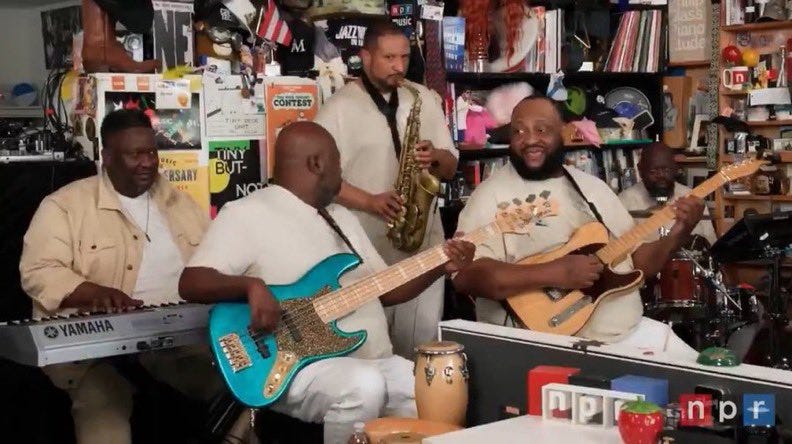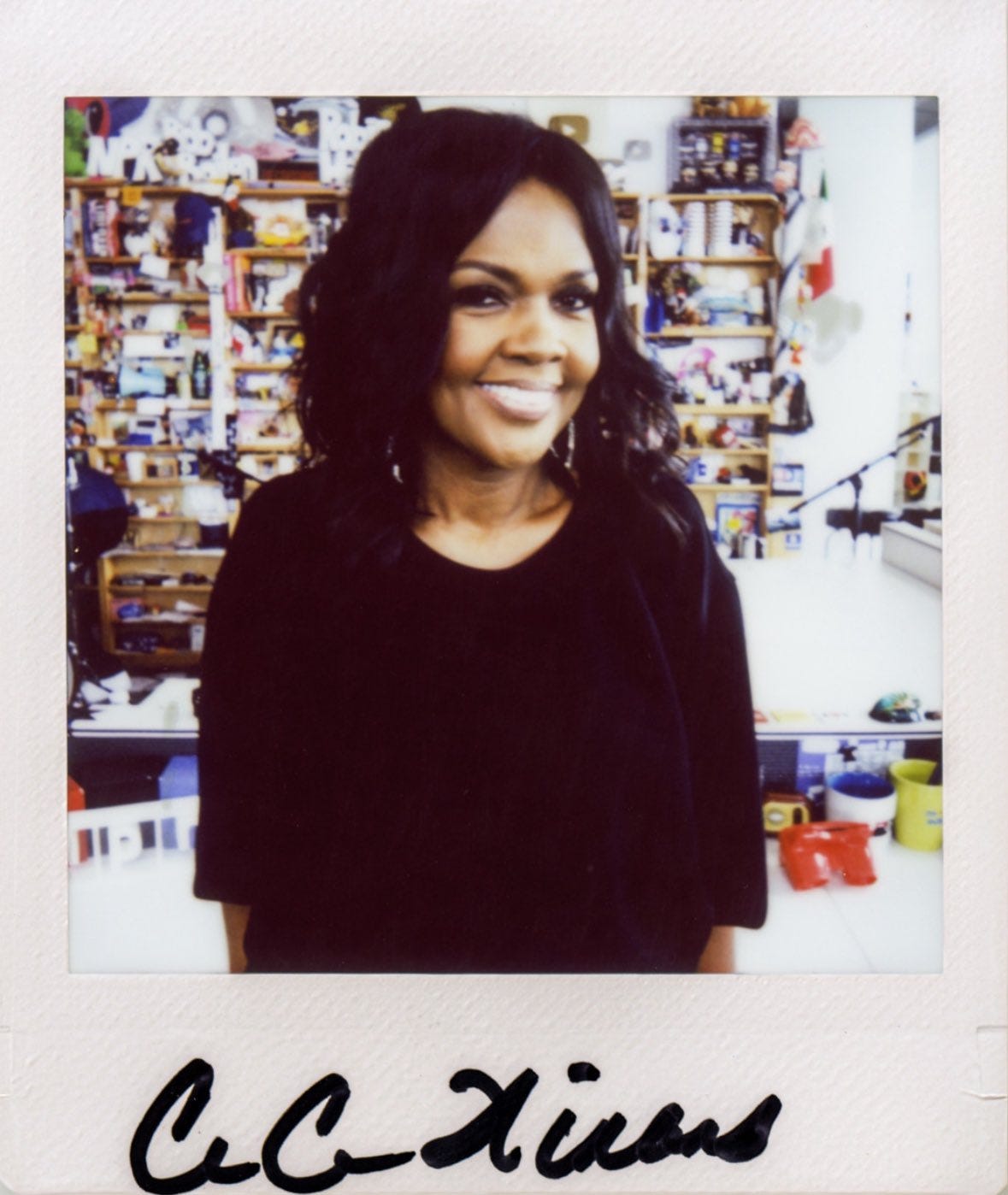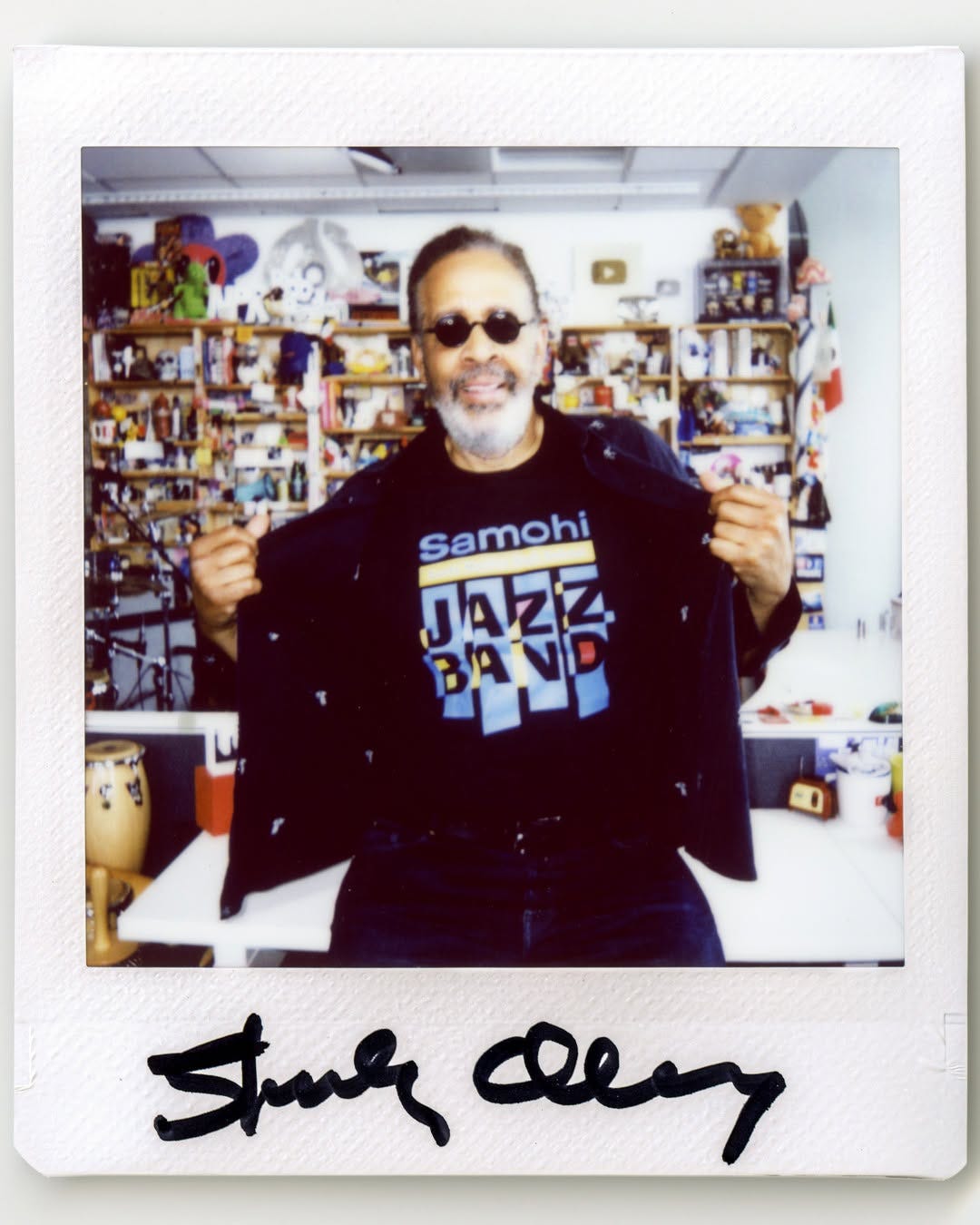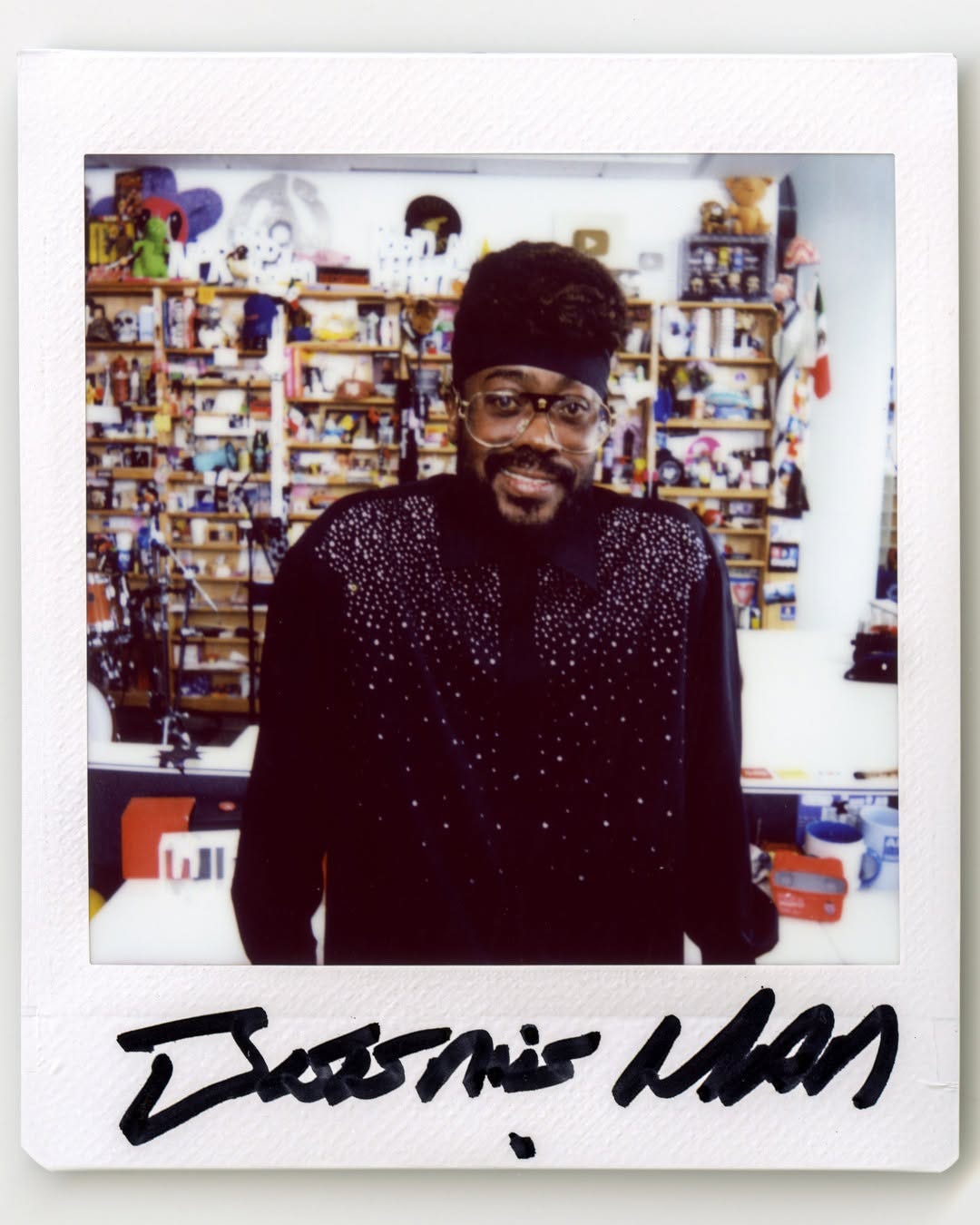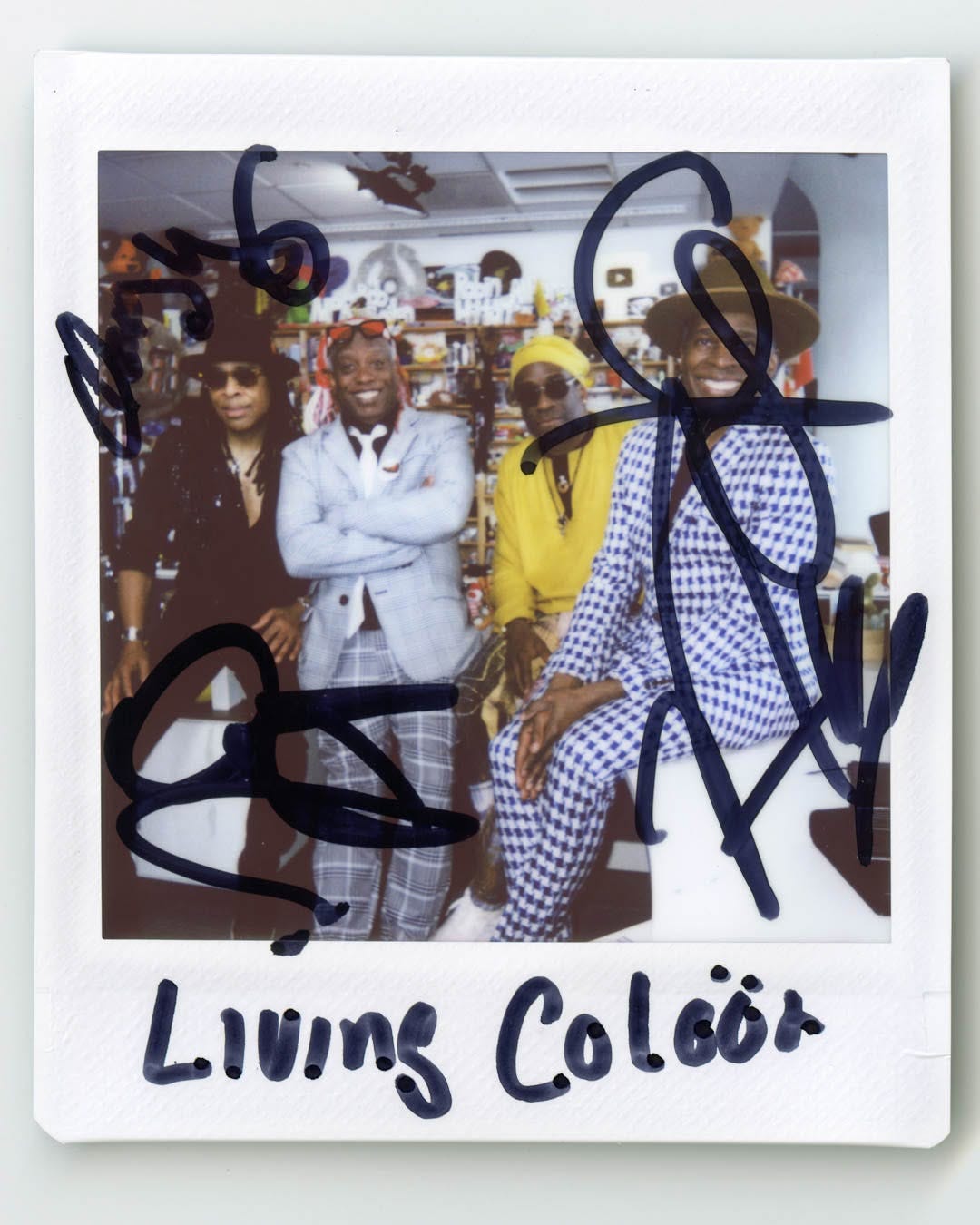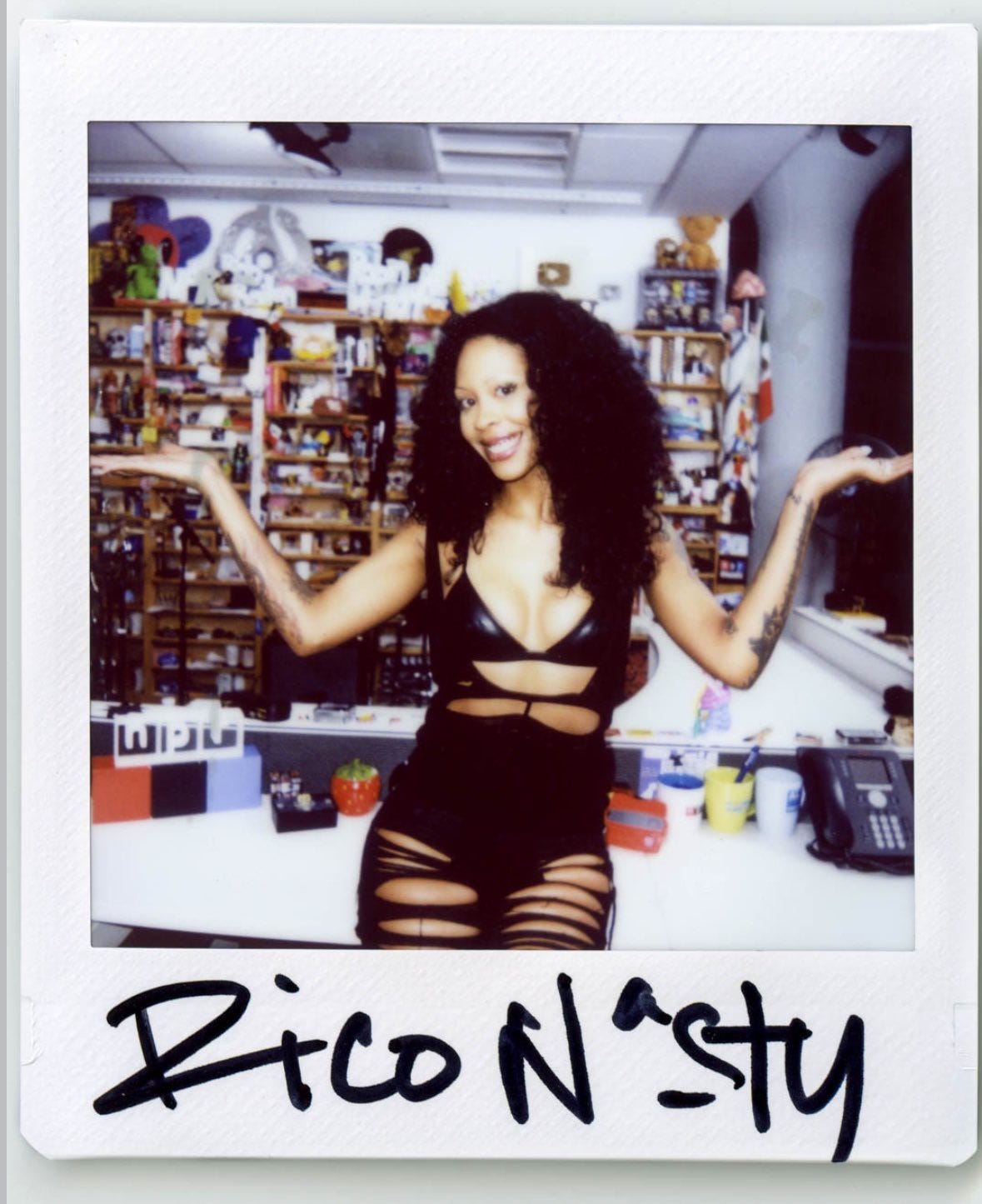Reviewing 2025’s Black Music Month Tiny Desk Album Anniversaries Tribute at NPR Music
After nine acts and countless moments of magic, NPR’s Black Music Month showcase proved to be more than just a nostalgia exercise.
After nine acts and countless moments of magic, NPR’s Black Music Month showcase proved to be more than just a nostalgia exercise. It was a living, breathing love letter to the legacy and future of Black music. By centering iconic albums from across eras and genres, the Tiny Desk team honored the pioneers (from E-40’s slang-laden rap hustle to Living Colour’s trailblazing Black rock) while shining a light on newer voices like Alex Isley and Rico Nasty. The result felt like a panoramic survey of Black music’s depths: past, present, and where it might go next. “These artists might not be the first you hear in the pop culture conversation, but they are crown jewels in Black culture,” Tiny Desk producer Bobby Carter noted, and on this stage, each jewel got to sparkle.
E-40
The month-long celebration kicked off in true Bay Area fashion with E-40 channeling the hyphy spirit that he helped pioneer. Despite three decades in the game, the Ambassador of the Bay moved with the energy of an up-and-comer. Backed by a slapping live band, he bounced through a multi-generational set list spanning his In a Major Way heyday to the “Tell Me When to Go” hyphy era. True to form, 40 Water peppered the performance with his signature off-kilter slang and tongue-twisting cadences—“I’ve been doing this since Kermit the Frog was a pollywog!” he quipped, drawing laughs. Every time he leaned into a wild new E-40-ism, the crowd hollered back in delight, practically finishing his sentences. The Tiny Desk office was, in his own words, “rockin’, “and for good reason. E-40 and company clocked weeks of rehearsal to condense 30 years of regional anthems into one tight medley. The payoff was a high-octane mini-tour of Bay Area rap history, from the classic rallying cry “Tell Me When to Go” to the TikTok-resurrected “Choices (Yup),” that set a high bar for those to follow. He was the first act of the series and indeed “delivered for them in every way,” kicking off Black Music Month with a bang. — Randy
Amerie
Not every set maintained that momentum. When Amerie took her turn behind the desk (flanked by D.C.’s own Backyard Band for go-go flavor), the chemistry never fully clicked. The R&B singer’s catalog is built on shapely, infectious grooves, but here those grooves felt undermined by evident rust. Her vocals showed noticeable strain, especially as she pushed into her upper register. By the time she reached the climax of her set, the famously high-flying hit “1 Thing,” her voice was noticeably overworked. You can’t help but note moments of cracking notes and shaky breath control, signs that her instrument was being taxed beyond its comfort zone. It didn’t help that the background singers often seemed out of sync, almost “at war with each other” instead of harmonizing as one unit.
This loose coordination suggested minimal rehearsal, and it showed because, rather than bolstering Amerie’s sound, the backups sometimes overshadowed and “bodied” her vocals or fell out of tune. To her credit, Amerie remained charismatic and gave her all, even improvising an impromptu crowd-call during the bridge of “1 Thing,” trying to liven up the room. But between the uneven mix and her vocal struggles, the performance drew mixed reactions. Some longtime fans cheered on the nostalgia, but largely the Hive went on attack mode (primarily because of the long-winded narratives of Amerie “stealing” Beyoncé’s sound), and many others were left disappointed, confirming the online chatter that this Tiny Desk just “wasn’t her best.” In a lineup celebrating excellence, Amerie’s set unfortunately became a case study in how preparation (or lack thereof) can make or break a live showcase, a reminder that even beloved hits need polish to shine truly. — Imani Raven
Wiz Khalifa
Wiz Khalifa’s approach swung to the opposite extreme, as the Pittsburgh stoner-rapper was so relaxed and faithful to his recorded style that at times it felt like the studio versions were playing. Dressed in casual cool, Wiz barely broke from his booth-ready, laid-back tone, a delivery so spot-on it was “like he never left the studio,” for better and worse. On one hand, that trademark mellow flow on classics from Kush & Orange Juice thrilled core fans with its authenticity; his verses rolled off the tongue with the same effortless cool that made the 2010 mixtape a cult favorite. On the other hand, the lack of stage dramatics made the set feel static at first. Wiz mostly kept his eyes closed and his voice on autopilot, completely in his element but rarely acknowledging the live audience. In fact, an odd tension hung in the air—“something was happening during the entire show and lots of us in the room could feel it,” producer Bobby Carter observed.
After a few songs of near silence between tracks, Carter actually stepped in to remind Wiz he could engage the crowd, but the rapper still “didn’t” break from his zone. It wasn’t until the final number that emotion finally cracked the cool façade. During the closing song (“Crime Bud and Women”), Wiz became visibly choked up. As the band hit the last note, he wiped away tears and at last addressed the room, “You made me cry. Fuck y’all!” he blurted through a laugh, prompting cheers and knowing laughs from the audience. In that fleeting moment, the Taylor Gang general showed genuine vulnerability, and the Tiny Desk felt intimate in a whole new way. Was his set invigorating or too low-key? In truth, it was both: an uber-faithful recreation of his hazy sound that gradually built to a surprisingly heartfelt payoff. If fans initially found his aloofness frustrating, by the end, Wiz had proven that even the chillest persona can still feel something, and sometimes a single unscripted tear can unite a room more than all the banter in the world. — Reginald Marcel
CeCe Winans
Backed by a minimalist band and three soulful backup vocalists, CeCe Winans transformed the Tiny Desk into a praise-filled enclave. Her set was an airtight medley drawn largely from Alone in His Presence, the landmark debut whose 30th anniversary she was commemorating. Winans glided from hymn to hymn in a carefully curated flow, “I Am” into “More Than What I Wanted” into an abridged “Alabaster Box,” and so on, blending timeless classics with newer favorites in seamless transition. The result felt like one continuous devotion. At several points, she invited the audience to sing along, and the response was immediate, as notably, the small invited crowd knew every word, effectively becoming her impromptu choir. Hands were raised, heads were nodding; for 20-odd minutes, a midweek Tiny Desk concert took on the atmosphere of a midweek church service.
Between songs, Winans offered brief affirmations and testimonies, further blurring the line between concert and worship. Her command of the room was absolute and effortless. Remarkably, CeCe performed without a handheld microphone, relying solely on the room’s natural acoustics, yet her voice lost none of its power or clarity. She belted out notes that hit the back wall of NPR’s offices as if it were a concert hall, then pulled back into tender whispers that had listeners leaning in on every syllable. “Whew… and that was with no amplification,” she said with a smile at one point, drawing astonished applause. Backed by gentle guitar and three-part harmony, Winans showcased the dynamic range of Black gospel: from quiet, contemplative moments of surrender to full-throttle, testifying crescendos that gave everyone goosebumps. By the finale of “Pray,” fittingly, a benediction of hope, the Tiny Desk had never felt more sanctified. CeCe Winans not only honored the legacy of her album but also created a moment that affirmed the healing, communal power of gospel music in real time. — Murffey Zavier
Stanley Clarke
From spiritual grace, the program shifted to jazzy virtuosity. Celebrating 50 years since School Days, Stanley Clarke showed the Tiny Desk why he’s a living bass legend. A literal wall of amplifiers formed the backdrop (a rare sight in the cozy space), signaling that Clarke’s trademark robust sound was not about to be compromised. Leading a young ensemble he dubbed 4EVER (a nod to his fusion roots with Return to Forever ), Clarke delivered a set that was equal parts music history lesson and jaw-dropping jam session. The maestro opened with the upright bass, playing the lyrical “Song to John,” a tribute to John Coltrane, allowing his protégés to shine early on. Pianist Cameron Graves and guitarist Colin Cook traded nimble melodies as Clarke laid down a warm foundation, hinting at the generous spirit of mentorship that defines his current chapter. Then, with a grin, he switched to his iconic electric bass and launched into “Yesterday Princess,” a 1970s deep cut that brought violinist Evan Garr to the forefront for a breezy, bluesy solo. Each number built on the last.
By mid-set, Clarke and company hit a stride with “1, 2, To The Bass”—a mid-2000s groove that somehow managed to be “both smooth and funky at the same time,” as one observer noted. Indeed, one minute the band flowed through a silky, neo-soul vibe; the next, they’d pivot on a dime into a hard-slapping funk break, with Clarke’s fingers dancing at lightning speed across the frets. Drummer Jeremiah Collier’s playful tom-tom buildup announced the final tune, and in came that unmistakable riff: “School Days.” Clarke thumped out the syncopated bass line with youthful vigor, eliciting cheers from the NPR staffers who recognized it immediately.
It was a full-circle moment, more than 50 years after he first recorded it; the song’s bass solo remains a jaw-dropper, and Clarke tore into it as if to prove he’s still got “it.” By the end, he had indeed proven it and then some. “A little over 50 years since his solo debut, Clarke reminds the audience that there are still new ways to be dazzled by the innovative and solid fullness of his instrument,” wrote NPR’s Mitra Arthur, perfectly summing up the set. The fusion pioneer not only showcased his own agility and improvisational flair, but he also bridged generations on that tiny stage, linking the 1970s jazz-rock revolution to the present day without a single dull moment. — Nehemiah
Beenie Man
If Clarke’s set fed the mind, Beenie Man’s fed the body and the soul with pure kinetic energy. The King of Dancehall sauntered in dripping with swagger (shimmering black shirt, fedora tilted just so) and proceeded to turn the Tiny Desk into a Kingston bashment party. Backed by Jamaica’s famed Ruff Kut Band, Beenie ignited a contagious dancehall pulse from the first drum kick. The office space instantly felt too small for the vibe he brought; you half-expected a foghorn sample or a “Pull up!” at any second. Instead, the band kept it tight and live, rolling from one classic riddim to the next.
Beenie Man has hits for days, and he packed as many as possible into the set. He wasted no time dropping into crowd-favorite call-and-response chants, flashing a grin as the audience echoed back every “Sim Simma!” on cue (yes, he gave us a snippet of “Who Am I” and the room absolutely lost it). He slid into the sensual, reggaeton-tinged “Romie” shortly after, hips swaying and shoulders bouncing, showcasing the infectious stage presence that earned him his crown. Even in a seated office, people were dancing, or at least attempting a steady head bop while crammed between cubicles.
What really impressed was how deftly Beenie Man and band navigated rhythmic shifts to keep the momentum peaking. One moment they’d lock into a slinky, laid-back groove, and the next they’d accelerate into a high-voltage dancehall breakdown that had everyone shouting. He would egg on his players with a classic “Come again!” and they’d flip the beat, old-school sound system style. In between songs, the self-proclaimed Doctor dropped bits of patois banter and hyped up each band member, effectively acting as his selector and MC. Despite the party atmosphere, the set was also a celebration of longevity. Beenie noted on mic that “I’ve been doing music since the age of 5… now I’m 50-something and I’m doing the same thing,” a statement not of weariness but of pride.
He honored the 25th anniversary of his Grammy-winning album Art and Life in style, performing its hits like “Girls Dem Sugar” with undiminished flair. Decades into his career, his voice is still elastic and commanding, effortlessly shifting between a gruff singjay toast and sweet crooning on cue. Beenie Man had the entire room singing “Zagga zow!” and feeling like we’d been to a carnival. The call-and-response energy, the rocksteady-to-dancehall rhythmic ride, and the sheer joy of it—these elements, in a series dedicated to Black music history—Beenie’s segment was a visceral reminder that history can be a living, sweating, hip-shaking present. (And when it was over, more than a few folks were heard wishing the set was longer.) — Jamila W.
Alex Isley
On the heels of that dancehall explosion, Alex Isley took the vibe in a very different direction—downshifted into an atmosphere of lush, ethereal R&B. Fans had waited years for the daughter of R&B royalty (her dad is Ernie Isley of the Isley Brothers) to do a proper Tiny Desk, and she rewarded the anticipation with a set that can only be described as exquisite. Isley’s approach was subtlety and intimacy personified: sparse arrangements, delicate dynamics, and a voice like a cloud drifting through a sunbeam. Throughout her performance, the room was palpably hushed—you could hear the tiniest vocal inflection, each fluttery run, and breathy whisper, because the audience was hanging onto her every word.
Opening with the cheeky new groove “Mic On,” Alex immediately set a mellow tone. The song’s studio version is a thumping, KAYTRANADA-produced bop, but live, it was reimagined into a laid-back jam, all the better to let her dreamy vocals shine. Backed by a tight band and three immaculate background singers (including alt-R&B artist Muhsinah), Isley glided through complex melodies without ever sounding like she was trying; her vocal agility felt completely unforced. She’d hit an airy high note and then slide into a silky lower register like it was nothing, all while maintaining a kind of zen poise. The set list was a journey through her decade-long career, and she segued between songs so smoothly it felt like turning pages of a story. Early on, she flowed from the feathery midtempo “Mic On” straight into fan-favorite “Good & Plenty,” without missing a beat.
On the latter, she even had a surprise up her sleeve while midway through the sultry groove on the hook, out popped neo-soul star Masego with saxophone in hand, ready to deliver his guest verse. The crowd, already mesmerized, erupted in a roar of delight at this unannounced appearance. As Masego’s sax riffs intertwined with Alex’s voice, the Tiny Desk felt like an intimate jazz club for a moment, soaked in cool vibes. After that high point and a round of raucous applause, Alex Isley gently brought the focus back to herself. “Hi, I’m Alex,” she said with a shy smile (her first real spoken introduction of the set), then noted that in addition to newer material from her EP When, she was here to celebrate the 10th anniversary of her album, L U X U R Y.
With that, she eased into “La Brea,” an ode to her Los Angeles roots, followed by the dreamy 2010s cuts “Into Orbit” and “About Him.” Each song flowed into the next, guided by DeShaun Allen’s artful music direction, and each earned appreciative snaps and applause. In the final stretch, Alex delivered a one-two emotional punch with “Love Again” and “Mine” (from her collabs with producer Jack Dine ), sounding “angelic” on the delicate harmonies. The room was silent at this point, everyone drawn in by the understated passion in her voice. During the pin-drop ballad “Hands,” you could practically feel the crowd holding its collective breath – she had them in the palm of her hand, completely engrossed. After thanking NPR and her band, Alex closed with the fitting “Thank You for a Lovely Time.” The song’s recorded version is wistful and melancholy, but in this setting, it becomes something hopeful—a gentle, sincere goodbye that leaves a lovely afterglow.
There was a brief moment of stillness, followed by a standing ovation. Alex Isley’s Tiny Desk was a quiet triumph that was years in the making, over in a flash, and worth every second. She proved that in an environment where so many artists try to go big, sometimes the most powerful thing you can do is go soft and sing your truth. — Tai Lawson
Living Colour
To reinforce that Black music contains multitudes, the Tiny Desk next welcomed a group who have been shattering genre ceilings since the ‘80s: Living Colour. If anyone in the audience still doubted that “rock ‘n’ roll is Black music,” this set surely blasted that notion away. The veteran rockers hit the stage celebrating 35 years of their incendiary album Time’s Up, and from the downbeat, they made it clear that intensity and message were the name of the game. Amazingly, NPR managed to squeeze Living Colour’s big, loud sound into the tiny space without losing its punch—“Did we really squeeze the big sound of Living Colour behind the Tiny Desk? Yes, we did. And yet, the band lost none of its intensity at a slightly lower volume,” NPR noted with pride.
The set opened, appropriately, with the band’s anthem “Cult of Personality.” Even at a reduced volume, that famous riff and Corey Glover’s soaring wail cut through the office air like a clarion call—heads started banging (or nodding vigorously, at least) the moment guitarist Vernon Reid shredded the first power chord. After that initial shot heard around the world, Living Colour dedicated the rest of their set to Time’s Up material, framing the importance of that album in rock history. “Time’s Up planted a flag for Black rock bands,” NPR’s blurb reminded us, drawing inspiration from trailblazers like Jimi Hendrix, Motown grooves, and the Black punk pioneers Bad Brains. In fact, before launching into the frenetic title track “Time’s Up,” frontman Corey Glover gave a heartfelt shout-out to Bad Brains, explicitly connecting the dots between generations of Black rock rebellion.
The instrumental interplay in this performance was a marvel. Vernon Reid unleashed his full arsenal of guitar sorcery – from lightning-fast solos to whammy-bar dive bombs to bursts of feedback – essentially a living history of rock guitar techniques compressed into a single minute. Locking in with him, bassist Doug Wimbish and drummer Will Calhoun were a powerhouse, delivering deep, churning grooves one moment and tight, punky blasts the next.
They seamlessly shifted dynamics, proving they could be just as potent grooving at a simmer as they are at an arena roar. Corey Glover, clad in his signature bodysuit, belted and snarled with undiminished range—his high notes pierced the air, and his passionate growls gave weight to the socially charged lyrics that define Time’s Up. Indeed, Living Colour made sure to accentuate the messages in their music. Songs like “Time’s Up” and “Information Overload” (which they performed) address environmental crisis and media saturation, themes as relevant now as in 1990, and hearing a Black rock band preach these truths in the halls of NPR felt like a full-circle moment for rock’s roots.
After a blistering take on “Type,” with its funk-metal riffage intact, Living Colour had proven that age hasn’t dulled their edge one bit. In the end, the band took a humble bow as the audience whooped and applauded, some folks clearly stunned by the controlled chaos they’d just witnessed. Rock’s Black lineage was on full display—past, present, and future—and in the Tiny Desk’s close quarters, Living Colour commanded the same attention and respect as they would on a festival stage. It was a loud, bold statement that Black music encompasses all genres, and they couldn’t have made that point any louder (literally). — Brandon O’Sullivan
Rico Nasty
To cap off this ambitious Black Music Month anniversary tributes came from Rico Nasty, representing the new guard with her genre-blurring punk-rap ferocity. Tasked with closing out the anniversary showcase, the 26-year-old DMV native delivered a high-octane finale that was as brash and dynamic as expected – if not exactly revelatory. By this point, the Tiny Desk crowd included a legion of her own “Nasty Mob” fans packed in up front, and Rico fed off their energy from the get-go. She hit the stage with full force, decked out in her edgy glam-punk attire and flanked by a live band of guitars, bass, keys, and drums.
From the first snarling riff, it was clear this wasn’t going to be a sleepy NPR-friendly set because if you know Rico, she comes to rage, and rage she did. Over the next twenty minutes, she proceeded to showcase every corner of her musical identity, just as her introduction promised. The set list zigzagged through her catalog, much of it honoring Nightmare Vacation, her debut album now 5 years old, and each song revealed a different facet of the Rico Nasty persona. She opened with a new track, “Who Want It,” spitting rapid-fire bars over a menacing trap-metal groove. Immediately after, she whipped out her tongue-in-cheek banger “TEETHSUCKER (YEA3X),” full of humor and screamo attitude, headbanging alongside her guitarists. The highlight of the early set was a left-turn featuring a smooth, reimagined version of “On the Low,” one of her more melodic cuts, which she crooned in a surprisingly gentle tone while the band played a downtempo, almost neo-soul arrangement behind her. It was a brief breather in an otherwise frenetic show, and it worked, giving a glimpse of the vulnerability she’s woven into recent projects such as her Lethal mixtape. But lest anyone think Rico was going soft, she then detonated her viral hit “Smack a Bitch,” complete with its screaming chorus and mosh-call breakdown.
The Tiny Desk turned into a punk show for a glorious few minutes, a couple of her fans couldn’t resist forming a tiny mosh pit (as much as one can in an office), and Rico herself was thrashing and jumping with a mic in hand. Her punk-rap volatility hit its peak here, with the all-girl band (a nice touch recalling her earlier Tiny Desk [Home] concert) amplifying the chaos at full tilt. From there, she tore through snippets of “Tia Tamera” (cheeky pop-trap fun) and “Rage” (as advertised, a straight-up rage track), then unveiled a brand new song, “Crash,” that blended emo-rock singing with double-time raps, evidence that she’s still evolving her sound. By the time she reached “Smile,” an emotive ode to her young son, both artist and audience had been on a rollercoaster of moods. She took a moment to catch her breath and express genuine gratitude to her supporters and family present, noting how “safe” she felt performing in her hometown for such a special occasion. It was a sweet, humanizing moment that contrasted with her brash image.
Rico Nasty closed out the concert series on a fiery, defiant note. If her set didn’t unveil any radically new dimension of her artistry (fans have seen her fluctuate between sweet and savage before), it certainly cemented her status as a commanding live force. She successfully bridged the gap between the old school and the new as a young Black woman who grew up on a wide range of genres, from rap to punk to pop, now blending them all together on her own terms. As an ending to an event about Black musical lineage, it felt fitting—a blast of unruly creativity that shows the lineage is alive and mutating in real time. — Phil
There were lessons in showmanship, resilience, crossing boundaries (musical and cultural), and the power of a song to unite people. Perhaps most importantly, the series hinted at growth still to come. Hearing gospel hymns in a news office, or mosh-pit anthems alongside classic soul, one couldn’t help but imagine new possibilities: collaborations across generations, genres born at their intersections, or maybe the next icon-in-the-making taking notes in the wings. Black music has always reinvented itself while staying rooted in community and truth. This anniversary-focused celebration showcased that dual nature—heritage and innovation hand in hand—and issued a joyful challenge for the future. If one thing is clear, it’s that Black music’s rich lineage is still being written, one Tiny Desk at a time, and its best chapters may yet lie ahead.




